Grow lights are specifically designed to ensure the basic requirements of simulating sunlight to grow indoor plants, to provide enough light in areas with little or no light at all, and to ensure the healthy growth of plants for all stages of growth.
Many types of grow lights are on the market to suit various indoor growing needs.
LED grow lights offer a full spectrum for indoor plants, are highly efficient, and reduce electricity for lighting needs. HID grow lights also offer a broad spectrum, but emit more heat and consume more power than LED. CMH grow lights offer a fuller spectrum than regular HID grow lights and are more efficient in a growing environment.
LEDs are the most popular lights and undergo technological advancements. However, laser diodes are getting more popular as they pump over 2,000 times as much light as the standard LED grow lights emit per square centimeter.
To choose the best grow light for an indoor garden, consider some crucial criteria, such as energy efficiency, light spectrum, quality, and ease of use. The full spectrum LED grow lights are the best choice for indoor plants based on such conditions.
Compact fluorescent lights are easy to use and use less electricity than incandescent bulbs.
T5 lights are small in design, emitting a high output for indoor plants, with cooling operations for optimal growth.
The light spectrum includes all light colors, beneficial for indoor plant growth as they cover all stages of plant growth, from germination to flowering and fruiting.
Table of Contents
- 1. LED (light emitting diode)
- 2. Compact Fluorescent Lights (CFL)
- 3. T5 grow lights (and other fluorescent tubes)
- 4. High-Intensity Discharge (HID)
- 5. Metal Halide (MH)
- 6. High Pressure Sodium (HPS)
- 7. Ceramic Metal Halide (CMH, LEC, Light Emitting Ceramic)
- 8. Fluorescent
- 9. Incandescent
- 10. Halogen (halides)
- How to choose a grow light: 9 steps for picking the best grow light
- What Color Light is Best for Plant Growth?
1. LED (light emitting diode)
- Light quality: 5/5 (adjustable wavelengths and full spectrum for all growing stages)
- Ease of use: 5/5 (quick setup without a ballast. Less heat output than HID lamps, so there’s no need for a ventilation system)
- Value for money: 4/5 (too expensive compared to other light types)
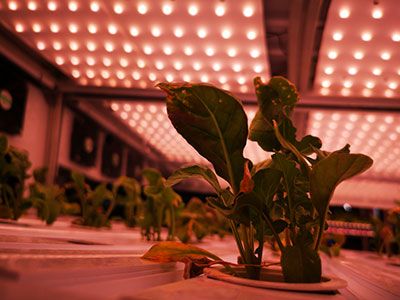
Due to technological advancements, LED lighting is expected to dominate 100% of lighting sales by 2025. The main technological advantage is the smart system with a WiFi connection and apps to control the lights and ensure optimal plant growth.
LED grow lights are designed to provide the specific spectrum of light that plants need for photosynthesis. They consist of small, powerful, light-emitting diodes that emit different light colors. LED tubes simulate the full spectrum of sunlight, which is essential for plant growth.
LED lights are superior to traditional grow lights (HID, HPS lights) in terms of efficiency and operating costs. They consume less energy, produce more light per watt, and have a longer lifespan.
Temperature control in the growing space is easier with LED lights, as they generate significantly low heat compared to other grow lights. They reduce the risk of overheating and damaging plants and eliminate the need for additional cooling systems.
LED lights maintain their brightness over time better than other types of lights. They don’t ‘burn out’ like traditional bulbs – instead, they gradually decrease brightness over time.
Installing and setting up LED grow lights is generally straightforward. They come with user-friendly features such as plug-and-play installation and adjustable light spectrums.
LED grow lights improve the growth rate and yield of plants. The ability to provide optimal light conditions enhances photosynthesis, promoting faster growth and higher yields.
LED lights are highly praised for their energy efficiency, long lifespan, and versatility. However, they have a higher upfront cost than other lights.
Compared to LED lights, high-pressure sodium (HPS) lights produce intense light that is beneficial for various stages of plant growth, especially the early stage. However, they also produce more heat and consume more electricity than LED lights. LED grow lights are energy-efficient, less bulky, and can be plugged directly into a standard electrical outlet without needing a separate ballast and reflector. They also emit less heat, making them a practical choice for many growers.
Compared with fluorescent lights, LED lights are more energy-efficient, durable, and longer-lasting than fluorescent lights. They also provide more intensity per watt, making them better for promoting plant growth. Fluorescent lights are cheaper upfront and produce a good spectrum of light for plant growth, but they are less efficient and require more frequent replacement.
You can use regular LEDs for plant growth, but specialized LED grow lights yield superior results. Regular LED bulbs and strips predominantly emit white light, supporting basic plant development. For optimal growth and flourishing, plants require both blue and red light, which are readily supplied by LED grow lights.
- Energy efficiency due to reduced electricity required for high output of light
- Easy to install and use since they require only a plug socket
- Easy to maintain as they come with built-in cooling systems
- Customizable color spectrum for different growing stages
- They are not affordable to all users, as they can be quite expensive
- You must replace the entire lighting system if one part is damaged or broken
2. Compact Fluorescent Lights (CFL)
- Light quality: 3/5 (the quality is harsh, not as soft as LED or incandescent lights)
- Ease of use: 4/5 (quick setup, but requires time to emit full brightness)
- Value for money: 4/5 (high initial cost, but not as quality as LED lights)
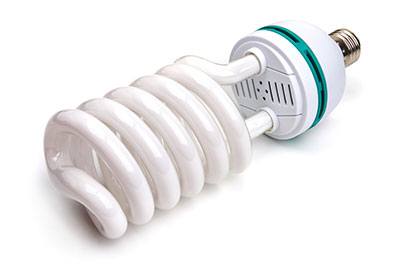
Compact Fluorescent Light (CFL) bulbs have undergone several major technological developments. They are designed to replace standard incandescent bulbs and can use up to 75 percent less energy, lasting up to 10 times longer, roughly 5,000 to 10,000 hours.
In a CFL grow light, an electric current is driven through a tube containing argon and a small amount of mercury vapor. The current generates invisible ultraviolet light that excites a fluorescent coating (called phosphor) on the tube’s inside, emitting visible light.
CFLs have been deemed as one of the greatest developments in lighting since the 1879 incandescent due to recent advances in technology and reduced costs. However, they do have some drawbacks. For instance, volume was an issue in CFL development since the fluorescent lamps had to fit in the same volume as comparable incandescent lamps.
The light spectrum of CFLs is generally good for growing plants, but they may not be as efficient as other types of grow lights (LEDs) due to harsh light quality.
CFLs tend to produce less heat than incandescent bulbs, making them a safer choice for indoor use. However, they still get hot, especially if used in enclosed fixtures. Compared to incandescent bulbs, CFL grow light is far more energy-efficient and has a longer lifespan. While incandescent bulbs convert most of their energy into heat rather than light, CFLs use about 70-80% less energy and last up to 10 times longer.
CFL bulbs are also easy to install – designed to fit into standard light sockets. However, handling them carefully is important to avoid breaking the bulb and releasing a small amount of mercury vapor inside.
They are low-cost, consume less electricity, and are easily available. CFLs are highly customizable and do not require any special fixtures for installation. They are used during any phase of a plant’s growth cycle, with certain color temperatures being more beneficial for different stages.
Compared to incandescent bulbs, CFL grow light is far more energy-efficient and has a longer lifespan. While incandescent bulbs convert most of their energy into heat rather than light, CFLs use about 70-80% less energy and last up to 10 times longer.
Compared to LED light systems, CFLs are cheaper to purchase and can produce a good light spectrum for growing plants. But they need to be replaced more often than LEDs. LED lights are more energy-efficient than CFLs and produce less heat. However, they are more expensive upfront.
- Affordable, as CFL grow light is cheaper than LED light
- CFL grow light systems are available online and in stores
- Versatile for installation with light sockets without a fixture
- They are good for small spaces due to their smaller size
- Not as energy-efficient as LEDs
- They generate more heat for a small, enclosed space
- They have a short lifespan, so they need frequent replacement
3. T5 grow lights (and other fluorescent tubes)
- Light quality: 4.5/5 (intense light and wide coverage, but extra care required to prevent plant burns)
- Ease of use: 4/5 (easy to use as they fit standard light sockets; however, they need adjustments to prevent plant burns when they touch tubes)
- Value for money: 4/5 (less expensive than LED lights, offering good performance, but not as long-lasting as LEDs)
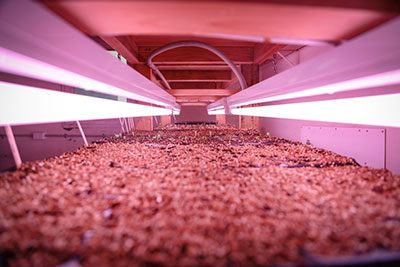
T5 grow lights are designed to be highly efficient and compact. Traditionally, they were fluorescent, but with the progression of LED technology, many T5 grow lights are now LED-based. This shift has resulted in more energy-efficient lighting solutions that require less maintenance and provide superior luminosity.
The efficiency and operating costs of T5 lights have improved due to incorporating LED technology. LEDs consume less power and have a longer lifespan than traditional fluorescent bulbs, leading to lower operating costs for T5 lights.
T5 lights, especially LED versions, generate less heat than their counterparts, making it easier to control the temperature in the growing space. They help maintain an optimal climate for plant growth without overheating the environment.
In terms of brightness, T5 lights have shown less loss over time due to the robustness of LED technology. LEDs maintain their brightness for longer periods, reducing the frequency of bulb replacement.
Installing and setting up T5 lights is straightforward. They are usually lightweight and come with fixtures that allow easy mounting. Their models even offer plug-and-play convenience.
The flexibility in adjusting the artificial light spectrum is another significant feature of T5 lights. Models allow growers to tune the light spectrum and cover all growing stages of the plants, enhancing plant growth and yield.
T5 lights have been associated with improved plant growth rate and yield. Their powerful illumination ensures that plants receive adequate light for photosynthesis, contributing to healthier and more productive growth.
The “T” in “T5” stands for “tubular,” indicating the shape of the bulb. The number following the “T” represents the bulb’s diameter in eighths of an inch. Therefore, a T5 bulb is a tubular bulb that is 5/8ths of an inch in diameter.
Comparing T5 with High-Pressure Sodium (HPS), Metal Halide (MH), and Ceramic Metal Halide (CMH) lights, T5 lights are more energy-efficient and produce less heat. However, HPS and MH lights are more powerful, making them suitable for larger growing spaces.
T5, T8, and T12 are all types of fluorescent lights that differ mainly in diameter. T5 lights have a diameter of 5/8th of an inch, T8 lights have a diameter of 1 inch, and T12 lights have a diameter of 1.5 inches. T5 lights are typically more efficient than T8 and T12 lights.
Compared to LED lights, T5 lights are known for their efficiency and cool operation, but LED lights are even more energy-efficient and have a longer lifespan. LEDs also provide the flexibility to adjust the light spectrum, enhancing plant growth.
T5 LED lights are considered better than traditional T5 fluorescent bulbs because they consume less energy, last longer, and maintain their brightness over time. They also generate less heat, reducing the risk of overheating plants in the growing space.
- T5 lights are more energy-efficient than older types of fluorescent lights, such as T8 and T12.
- They generate less heat than other grow lights, reducing the risk of overheating plants.
- Due to their small size and low heat output, they’re perfect for small growing spaces or indoor gardening.
- T5 bulbs provide uniform light distribution, which benefits young plants and seedlings.
- T5 lights are generally cheaper to purchase than LED or HID lights.
- T5 lights don’t provide enough light intensity for larger plants or flowering stages.
- T5 bulbs typically have a shorter lifespan than LED lights.
- Traditional T5 lights do not offer the full light spectrum for optimal growth.
- Because of their shorter lifespan, they must be replaced more often than LEDs.
4. High-Intensity Discharge (HID)
- Light quality: 4.5/5 (high light output, covering a broader spectrum, but posing a risk of excessive heat and plant burns)
- Ease of use: 3/5 (complex installation due to additional ballast. Requiring ventilation or cooling systems)
- Value for money: 3.5/5 (higher electricity costs, additional installation costs, but more effective than fluorescent lights)
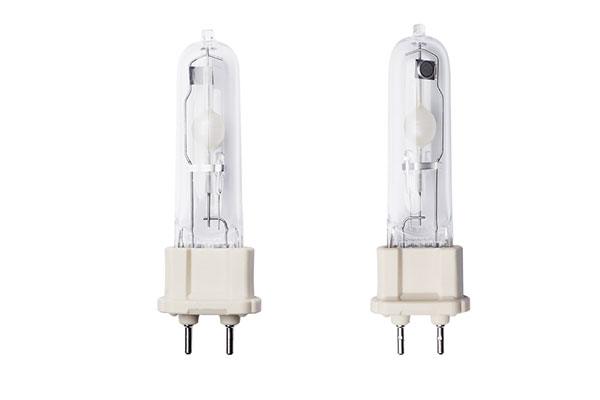
High-Intensity Discharge (HID) lights have seen significant advancements over the last few years. These advancements have made them one of the most energy-efficient lighting devices on the market.
HID grow lights, including popular types like High-Pressure Sodium (HPS) and Metal Halide (MH), are designed to last up to 5 times longer than standard halogen lamps. They are similar to daylight and offer more brightness, providing plants with a powerful light source.
HID lights have improved efficiency and operating costs, but they still consume more energy than their LED counterparts. They also have shorter lifespans, leading to higher replacement costs.
Controlling the temperature in a growing space using HID lights can be challenging. These lights generate more heat than T5 or LED lights, potentially increasing room temperature and risking overheating plants.
As for brightness over time, HID lights lose their intensity faster than LED lights. They need to be replaced more frequently to maintain optimal light levels2.
Installing HID lights is more complex than setting up T5 or LED lights. They usually require separate ballasts and reflectors, making the setup process a bit more involved.
HID lights do not offer the same flexibility as LEDs, adjusting the light spectrum. While MH lights are better for the vegetative stage and HPS lights are better for the flowering stage, neither offers the full-spectrum coverage that some LED lights provide6.
HID lights have traditionally been the go-to choice regarding plant growth rate and yield. They produce intense light that can drive strong plant growth. However, this comes at the cost of higher energy consumption and heat production.
While HID lights have advantages, they are not the best choice for every grower. Given their high heat output and energy consumption, they can be overkill for small-scale or hobby growers.
Compared to LED grow lights, there are better choices than HIDs. LEDs are more energy-efficient, have longer lifespans, generate less heat, and offer greater flexibility in light spectrum control. However, HIDs provide better light intensity and increase CO2 levels better than LEDs.
Still, the popularity of HPS and MH lights remains, particularly for commercial growers who require high-intensity light over large growing areas. However, the trend is increasingly moving towards LEDs due to their numerous advantages.
- High light intensity for flowering stages of indoor plants.
- HID lamps promote plant growth and yield due to the light spectrum.
- Strong heat output to cover all growing stages of indoor plants
- HID lights generate more heat than other types of grow lights
- They consume more energy than LEDs, leading to higher operating costs.
- HID lights have a shorter lifespan, so they must be replaced more often.
- Installing HID lights is complex as they require separate ballasts and reflectors
- HID lights do not offer the same flexibility in adjusting the light spectrum
5. Metal Halide (MH)
- Light quality: 4.5/5 (broad light spectrum, rich in red and blue for vegetative stages. Not for flowering stages)
- Ease of use: 3.5/5 (need a ballast or specific light fixture to operate. Changing bulbs is challenging due to high heat temperatures)
- Value for money: 3/5 (energy consumption and less lifespan than LED lights)
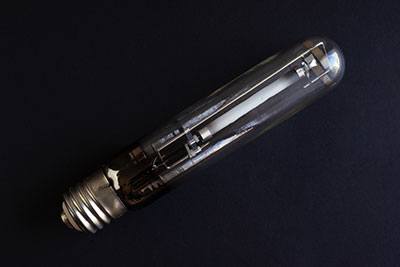
Technological advancements in Metal Halide (MH) lights have been substantial, although the rise of LED technology has overshadowed many of these improvements. The MH lights changed in design. They consist of an arc tube made of quartz or ceramic, filled with gas and metal halides. When an electric current is passed through, the gas ionizes and produces light.
While MH lights have improved efficiency, they still consume more energy than LEDs, leading to higher operating costs. However, they provide high-intensity light, making them a good choice for growers.
Controlling the temperature in a growing space with MH lights can be challenging. These lights generate significant heat, increasing room temperature and potentially harming plants if not properly managed, so you need ventilation systems for proper management.
MH lights tend to lose their intensity over time. They must be replaced every 6-12 months to maintain optimal light levels.
Installing MH lights involves setting up a ballast and reflector, which is more complex than setting up other grow lights like LEDs.
MH lights offer a broad spectrum suitable for the vegetative stage of plant growth. However, they don’t offer the same flexibility as LEDs in adjusting the light spectrum.
- Compared to incandescent bulbs, MH lights are 3-5 times more efficient.
- MH lights produce high-quality light. They are known for their vivid white light output.
- MH lights have been a reliable lighting technology for several years and have been used extensively in various applications, including horticulture.
- MH lights produce light at 360 degrees in all directions, which requires reflectors to direct the light properly.
- MH lights generate a significant amount of heat, which is a disadvantage in certain applications.
- MH lights may be cheaper to purchase but expensive to maintain. The bulbs need to be replaced regularly, adding to the operating costs.
- MH lights are still less energy-efficient compared to LEDs.
6. High Pressure Sodium (HPS)
- Light quality: 4/5 (high light output, rich in yellow and red. Suitable for flowering stage and for vegetative due to the lack of blue)
- Ease of use: 3.5/5 (need a ballast to install and use. Require additional ventilation or cooling system)
- Value for money: 3.5/5 (affordable, but energy consumption and additional installation costs cause more funds)
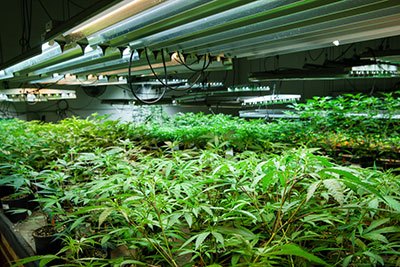
High pressure sodium (HPS) lights have recently seen a few technological advancements, including design, efficiency and operating costs, and temperature control.
HPS lights consist of a narrow arc tube made from alumina, filled with xenon gas and sodium-mercury amalgam. When an electric current is passed through, the gas ionizes, and the resulting plasma emits light.
HPS lights are known for their efficiency in terms of lumens per watt output. HPS light output is 40-150 lumens per watt, while LED light output is 37-120 lumens per watt. However, they consume more energy than LEDs, leading to higher operating costs.
It is required to control temperature in a growing space with HPS lights as they have a high heat output. Adequate ventilation is required to prevent overheating and plant death.
HPS lights lose their intensity over time and must be replaced regularly, typically every 9-12 months, to maintain optimal light levels.
Installing HPS lights involves setting up ballasts and reflectors, which are more complex than setting up other grow lights like LEDs.
HPS lights offer a red light spectrum that’s good for the flowering stage of plant growth. However, the HPS light does not mimic the natural sunlight as it has no blue-violet color range.
HPS lights have been favored for their ability to promote strong plant growth and yield, especially in the flowering stage.
If you’re growing plants that only need a vegetative phase (like lettuce or herbs), MH lights would be a better choice. If you’re growing plants that need to flower or fruit, you might want to start with MH lights for the vegetative phase and then switch to HPS lights for the flowering phase.
- HPS lights emit high-intensity light, making them suitable for large plants and flowering stages.
- HPS lights have been used in the horticulture industry for many years and have a proven track record for promoting the growth and yield of indoor plants.
- HPS lights generate substantial heat, leading to overheating issues if not managed properly.
- HPS lights consume more energy than LEDs, leading to higher operating costs.
- HPS lights have a shorter lifespan and need to be replaced more often.
- HPS lights do not offer the flexibility to adjust the light spectrum for indoor plants.
7. Ceramic Metal Halide (CMH, LEC, Light Emitting Ceramic)
- Light quality: 4.5/5 (for all growing stages)
- Ease of use: 4/5 (quick setup but need heat management)
- Value for money: 4/5 (more expensive than HPS, HID, and other light types)
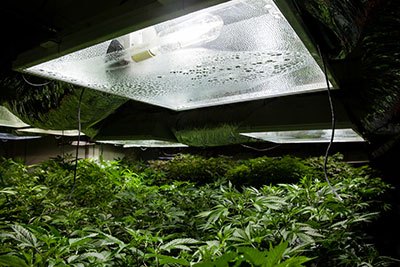
Ceramic Metal Halide (CMH) or Light Emitting Ceramic (LEC) lights have recently seen technological advancements. They are known for their efficiency, high-quality light spectrum, and relatively low heat output, which makes them a popular choice among indoor growers.
CMH grow lights are designed with a ceramic arc tube, similar to those used in HPS lights, withstanding higher temperatures and producing a more optimal light spectrum. The ceramic tube is filled with gasses and metal salts, which are ionized to produce light.
CMH lights are highly efficient, offering a high output of lumens per watt. However, they are more expensive than other types of grow lights, both in terms of initial cost and operating costs.
CMH lights generate less heat than HPS lights, making temperature control easier in the growing space. However, they still require proper ventilation to prevent overheating.
Like all HID lights, CMH lights lose brightness over time. However, they tend to have a longer lifespan than other HID lights, typically needing replacement every 1.5-2 years.
Installing CMH lights involves setting up a ballast and reflector, similar to other types of HID lights.
CMH lights provide a full-spectrum light that benefits all plant growth stages. However, they don’t offer the same flexibility as LEDs in adjusting the light spectrum. CMH lights promote strong plant growth and yield due to their high-quality light spectrum.
Some disadvantages of CMH lights include their higher initial cost, higher operating costs than LEDs, and the need for regular bulb replacement.
LEC is another term for CMH lights. It stands for Light Emitting Ceramic, referring to the ceramic arc tube used in these lights.
Both CMH and LED lights are energy-efficient and produce a high-quality light spectrum. However, LEDs are more energy-efficient, have a longer lifespan, and offer more flexibility in adjusting the light spectrum. On the other hand, CMH lights are known for their superior color rendering and broader spectrum.
Compared to HPS lights, CMH lights are more energy-efficient, produce less heat, and offer a better quality of light. However, HPS lights are cheaper and more suitable for larger growing spaces.
- They produce high-quality, full-spectrum light for all growing stages
- CMH lights offer high efficiency, with less costs and higher energy, compared to HPS or HID lights
- They have a longer lifespan and don’t need frequent replacements
- They produce a lower heat output not to burn plants
- Higher initial cost
- Higher operating costs compared to LEDs
- Less flexibility in adjusting the light spectrum compared to LEDs
8. Fluorescent
- Light quality: 3/5 (the light is harsh, not as warm as LED lights or incandescent lights)
- Ease of use: 4/5 (complicated installation due to required ballasts to control electrical current)
- Value for money: 4/5 (energy-efficient and durable, saving costs in the long run, but more expensive than incandescent bulbs)
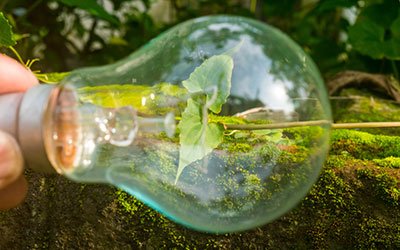
Technological advancements in fluorescent lights over the past few years have been significant, but they have also highlighted the limitations of fluorescent technology compared to other lighting technologies, particularly LEDs.
Fluorescent grow lights are designed with a phosphor-coated tube filled with mercury vapor. When an electric current passes through the mercury vapor, it emits ultraviolet (UV) light, which the phosphor coating converts into visible light.
Fluorescent lights last up to 10,000 hours, approximately ten times longer than an incandescent grow light bulb.
Fluorescent lights generate 30% less heat than HID lights, making it easier to control the temperature in the growing space.
Like all artificial lights, fluorescent lights lose brightness over time. However, their lifespan is still significantly longer than the incandescent grow light bulb.
Fluorescent lights are easy to install and set up. They come in tube-shaped bulbs easily fitted into standard light fixtures.
Fluorescent lights do not offer the same flexibility as LEDs in adjusting the light spectrum. However, they do provide a broad spectrum of light that’s beneficial for plant growth.
Fluorescent lights are suitable for propagating plants, growing greens, or growing plants that don’t require a lot of light, such as lettuce, spinach, or herbs. Fluorescent lights are less effective for larger plants or the flowering stage of plant growth.
- Fluorescent grow lights are generally less expensive than other grow lights, such as LEDs.
- They have a good light spectrum for growing plants, which is beneficial for photosynthesis.
- Fluorescent lights work well for small gardens and plants with low light requirements.
- Their design allows plants to grow vertically without the risk of burning, as fluorescent lights generate less heat.
- Fluorescent lights provide a reliable source of UV light for indoor plants.
- Fluorescent lights require minimal space and are easy to set up, making them perfect for small, stealthy grows.
- Fluorescent lights still need to be more energy-efficient compared to LED lights.
- Fluorescent lights have a shorter lifespan compared to LED.
- Fluorescent lights contain mercury, which is harmful to the environment if not disposed of properly.
9. Incandescent
- Light quality: 4/5 (warm light output but not as adjustable as LEDs)
- Ease of use: 5/5 (quick setup and easy to apply on standard light sockets)
- Value for money: 2/5 (cheap but not energy-efficient, with a short lifespan)
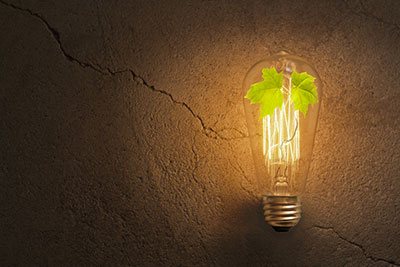
Technological advancements have been relatively slow for incandescent lights in the past few years, especially when compared to other lighting technologies such as LEDs. This is largely due to the inherent inefficiencies and limitations of incandescent technology.
Incandescent lights pass electricity through a wire filament, heating it until it glows. The light produced is warm and can closely mimic natural sunlight. However, they are not commonly used as grow lights due to their low efficiency and high heat output.
Incandescent lights are less energy-efficient than both fluorescent lights and LEDs. Much of their energy is wasted as heat, making operating more expensive.
Incandescent lights produce a lot of heat, increasing the temperature in a growing space. They are beneficial in cold climates but also lead to overheating and damage to plants if they are not properly managed.
Incandescent lights are known to dim over time, reducing their effectiveness for plant growth. The light output cannot cover all stages of plant growth, and there is insufficient light to boost and support seedlings and vegetation to grow strong and healthy.
Incandescent lights are easy to install and set up, similar to other types of lights (CFL or LEDs, as they fit standard sockets). However, they require more frequent replacement due to their shorter lifespan.
Incandescent lights can provide a broad spectrum of light, similar to sunlight. However, they could be more efficient at producing the specific wavelengths of light most beneficial for plant growth. They are ineffective in producing blue and red lights necessary for photosynthesis, vegetation, and flowering stages.
Due to incandescent lights’ inefficiency and high heat output, they are typically not the best choice for optimizing plant growth and yield.
- Incandescent lights can mimic natural sunlight, providing a broad spectrum of light.
- They are simple to set up and use.
- Incandescent lights are beneficial in colder climates.
- Incandescent lights are less energy-efficient compared to other types of lights.
- They can produce excessive heat and damage indoor plants.
- Incandescent lights typically have a shorter lifespan than other lighting options.
- They are not the best choice for optimizing plant growth and yield.
10. Halogen (halides)
- Light quality: 4/5 (excellent color rendering, but causing burns)
- Ease of use: 4/5 (easy to install but avid oil from fingers getting on the bulb, as it reduces their lifespan)
- Value for money: 3/5 (cheap but short lifespan and not energy-efficient)
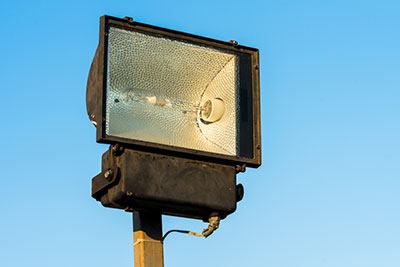
Halogen lights have seen limited technological advancements in recent years. Much of the innovation in lighting technology has been focused on LEDs due to their energy efficiency and longevity.
Halogen lights work by passing an electric current through a tungsten filament, which is enclosed in a small quartz envelope filled with halogen gas. When the filament heats up, it emits light. The halogen gas helps prolong the bulb’s life by redepositing tungsten back onto the filament.
Halogen lights are more efficient than traditional incandescent bulbs, but they are less efficient than LEDs or fluorescent lights. They also have higher operating costs due to their shorter lifespan and higher energy consumption.
Halogen grow light bulbs generate significant heat, challenging temperature control in a grow space. More heat leads to overheating and damage to plants if carefully managed. You must turn AC and other ventilation systems on to prevent plant burns.
Halogen grow light maintains its brightness fairly well over its lifespan, but they do not last as long as LEDs.
Halogen lights are relatively easy to install and set up, similar to other lights. However, they may require more frequent replacement due to their shorter lifespan7.
A halogen grow light bulb emits a broad spectrum of light, including ultraviolet light. However, they do not offer the flexibility of adjusting the light spectrum as LED systems do.
Halogen grow light is not the best choice for optimizing plant growth and yield. They generate a lot of heat and are not as energy-efficient as other types of lights like LEDs or CFL lights. They cannot support photosynthesis for optimal growth and healthy indoor plants.
- Halogen lights provide a broad spectrum of light, similar to natural sunlight.
- They are straightforward to set up and use.
- Halogen lights are less energy-efficient compared to LEDs.
- They can produce excessive heat, damaging plants.
- Halogen lights have a shorter lifespan.
- They are not the best choice for optimizing plant growth and yield.
How to choose a grow light: 9 steps for picking the best grow light
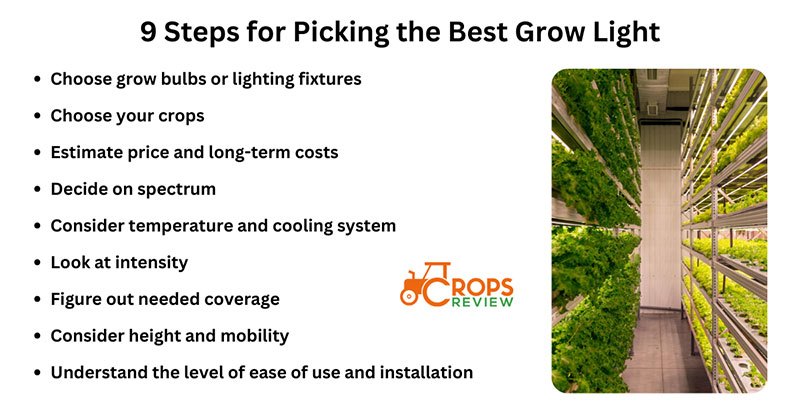
Indoor plant grow lights enable the cultivation of indoor plants, irrespective of the climate or time of year. The grow lights mimic natural sunlight, prompting photosynthesis and offering the correct color spectrum necessary for plants to thrive and flourish.
Choosing the right grow light can significantly enhance crop growth and yield, leading to increased profitability. It ensures plants receive the optimal light spectrum for photosynthesis, promoting healthier and faster growth.
Conversely, choosing the wrong grow light can stunt plant growth, reduce yields, and increase energy costs. A wrong choice results in financial losses and wasted resources.
Conduct thorough research before deciding to ensure you choose the most suitable grow light for your specific needs.
1. Choose Grow Bulbs or Lighting Fixtures
A light bulb is an electric device that produces light from electricity. It’s known as a lamp; the bulb part refers to the outer shell protecting the light-producing components inside.
Regular light bulbs, like incandescent bulbs, are not ideal for growing plants. They do not provide the full spectrum of light that plants need for photosynthesis. Fluorescent or LED grow lights are better suited for this purpose as they can provide the necessary blue and red wavelengths plants need for growth.
Grow light fixtures are specialized lighting devices designed to support plant growth by providing light that mimics the sun’s rays. The fixtures house various types of bulbs, including fluorescent, LED, HID, etc. They often have features like adjustable height, specific light spectrum controls, and built-in cooling systems.
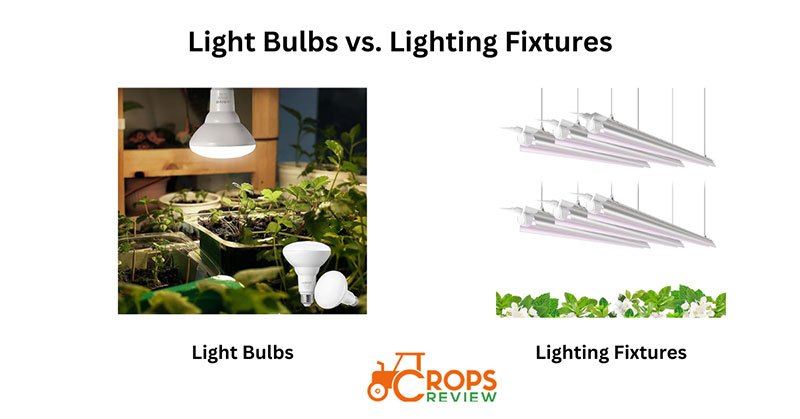
What Are the Main Benefits of Grow Light Bulbs?
- They encourage the photosynthesis process.
- They offer adjustable wavelengths for different growing stages.
- They are safe, convenient, and reliable light sources for indoor plants.
Pros of Grow Light Bulbs vs. Lighting Fixtures
- Versatility: Grow light bulbs are used in various standard light fixtures, giving you more flexibility in setting up your indoor garden. Bulbs fit in different lamps, while fixtures are immovable and support only one installation system.
- Cost-Effective: Individual grow light bulbs are cheaper than full grow light fixtures.
- Easy Replacement: When a grow light bulb burns out, it’s easy to replace without replacing the entire fixture.
Pros of Lighting Fixtures vs. Grow Light Bulbs
- Integrated Design: Grow light fixtures are specifically designed for plant growth, with features like reflectors to maximize light efficiency and distribution.
- Better Light Control: Fixtures often offer better control over the intensity and spectrum of light, leading to more optimal growth conditions.
- Durability and Longevity: High-quality grow light fixtures are often more durable and longer-lasting than individual bulbs.
- Heat Management: Many fixtures have built-in heat management systems to prevent overheating and keep plants safe from burns.
2. Choose Your Crops
Before buying a plant or initiating the seed germination process, assess the intensity and duration of natural light in your area. Then, select plants whose light needs align with the lighting conditions of your indoor space.
Although a plant might survive in low light conditions, it may need more light to encourage lush foliage and blooming, as the study at the University of Minnesota, named “Lighting for indoor plants and starting seeds,” states.
Low Light Conditions: (PPF: 50-150 umol m-2s-1 / 50-250 foot-candles / 10-15 watts)
Plants that thrive in low light don’t necessitate much, if any, direct light. In their natural habitats, they’re classified as “understory plants,” implying they grow beneath the larger plants’ canopy.
Such plants include snake plant, zee zee plant, English ivy, Parlor palm, and Chinese evergreen. The best light for such plants is LEDs.
Medium Light Conditions: (PPF: 150-250 umol m-2s-1 / 250-1,000 foot-candles / 15-20 watts)
Supplemental artificial lighting would be necessary for plants that require medium light for seed germination in medium light conditions. Similar to low-light plants, these plants won’t dehydrate quickly. To prevent excessive watering, it’s important to check the moisture content of the soil regularly.
The plants include Amaryllis, Ferns, rubber plant, spider plant, and Grape ivy. MH are good options for vegetative stages.
Intense Light Conditions: (PPF: 250-450 umol m-2s-1 / over 1,000 foot-candles, more than 20 watts)
Plants that thrive in high-light conditions are ideal for well-lit areas like south or southwest-facing windows. You can germinate seeds without the need for artificial lighting, but seeds requiring extended indoor periods, such as tomatoes and peppers, grow spindly without additional light.
High-light areas can get warm, causing plants to dehydrate more quickly. Monitor these plants more regularly and water them once the soil becomes dry.
Such plants include hibiscus, cacti and succulents, citrus, geraniums, and jasmine. HID lamps are the best options for such plants.
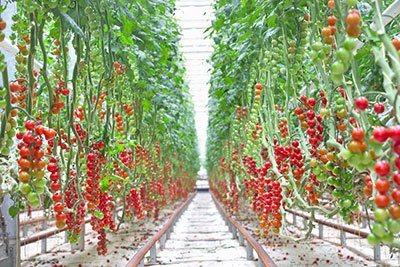
3. Estimate Price And Long Term Costs
Knowing your budget beforehand can simplify the shopping process, allowing you to rule out some choices immediately.
As you formulate your budget, consider your preferred energy expenses and the required illumination level. The power consumption of the bulbs you opt for directly impacts your energy expenditure.
For instance, if you have a 4×4 tent, you need 40 LED lamps of 10 watts, running for 14 hours every day, your cost is $17.04 per month. If you use 2×2, the cost is $4.26 per month due to energy efficiency.
Considering that most vegetables require approximately 30-40 watts of light per square foot for optimal growth, a 4×4 grow tent requires between 480-640 watts. If you’re using 40-watt fluorescent bulbs, you need 12-16 bulbs. A 2×2 grow tent requires between 120 and 160 watts of light. Using the same 40-watt fluorescent bulbs, you need 3-4 bulbs.
You’ll need to know your electricity rate to calculate the monthly cost.
Let’s say your electricity rate is $0.10 per kilowatt-hour (kWh). If you run a 40-watt bulb for 12 hours, it uses 0.48 kWh daily. If you use 16 bulbs for the 4×4 tent, they will use 7.68 kWh daily. Over a 30-day month, this amounts to 230.4 kWh. Therefore, the cost would be 230.4 * $0.10 = $23.04.
The 2×2 tent with 4 bulbs would use 1.92 kWh per day, or 57.6 kWh over a 30-day month. The cost would be 57.6 * $0.10 = $5.76.
4. Decide on Spectrum
The light spectrum refers to the range of colors (wavelengths) that are produced by a light source. It includes visible light (which we perceive as different colors) and non-visible light, such as ultraviolet and infrared.
The light spectrum matters significantly for plant growth because plants don’t use all light colors equally. Instead, they primarily use light in the red and blue parts of the spectrum for photosynthesis, which converts light energy into chemical energy for growth.
Seedlings and young plants typically need more blue light, which promotes strong root development and compact, bushy growth. Flowering and fruiting plants often benefit from more red light, encouraging blooming and fruit production.
As for quantifying the light spectrum, it’s typically represented as a percentage of total light output in each color band. For instance, a light produces 40% of its output in the blue spectrum, 30% in the green, and 30% in the red. If you’re exclusively growing microgreens, you don’t require full-spectrum light, as these plants need more blue light for growth.
While red and blue light are crucial for photosynthesis, other colors aren’t useless. Green light, for example, penetrates deeper into the plant canopy and may help lower leaves get some light.
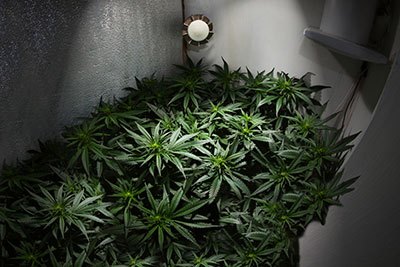
5. Consider Temperature and Cooling System
Strive for a temperature between 65-80°F (18-27°C) and humidity within 40-60%. Modify your ventilation system as needed if the temperature or humidity fluctuates beyond these limits. Turn on dehumidifiers and AC to reduce humidity and temperature to prevent overheating and burning of plants. The risk of overheating also includes burns out, fire threats, and short circuits if too many LEDs are turned on.
To prevent overheating, manage the temperature inside the grow tent effectively. Monitor and adjust the height of the lights to ensure they’re not too close to the plants, use fans or ventilation systems to help dissipate the heat, and check the temperature and humidity levels inside the tent regularly.
Conversely, increase humidity by using humidifiers and increase temperature if your humidity and temperature levels are too low for optimal growth.
6. Look at Intensity
Light intensity refers to the amount of light that a plant receives. It’s important for plant growth as it affects photosynthesis, the process by which plants convert light into energy.
To measure light intensity, use two key metrics: Photosynthetic Photon Flux Density (PPFD) and the Photosynthetically Active Radiation (PAR) chart.
PPFD measures the number of photosynthetically active photons that fall on a given surface each second. The unit is micromoles per meter squared per second (μmol/m²/s). This measurement helps determine how much usable light a plant receives for photosynthesis. If you have a 2×2 tent, plants need at least 500 (μmol/m²/s), while 4×4 tents require at least 800 (μmol/m²/s).
Conversely, the PAR chart visualizes light intensity distribution across a specific area. It shows how PPFD values change across the coverage area of a grow light. The chart displays how the light intensity is highest in the center and decreases towards the edges. Based on the light bulb you use, you get:
- 0.9 PPF/watt for CFL
- 1.4 PPF/watt for MH
- 1.9 PPF/watt for HPS SE
- 1.9 PPF/watt for CMH
- 2.1 PPF/watt for HPS DE
- 2.0 PPF/ watt for LED STD
- 2.4 PPF/watt for LED COB
The illustration of the PAC chart illustration explains the optimal range of PPFD values for cannabis:
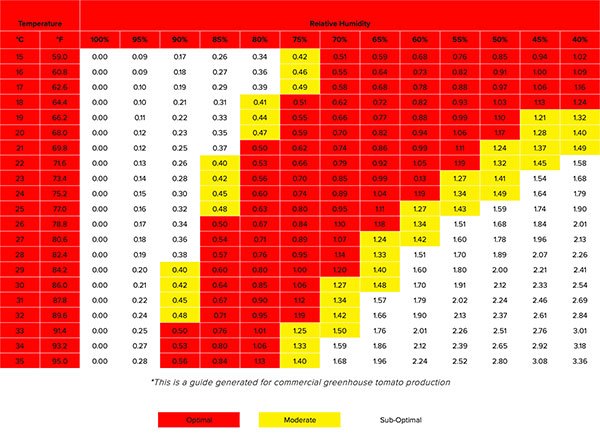
7. Figure out Needed Coverage
After you’ve shortlisted your potential grow light candidates, figure out how many you require.
Start by sizing up your growing area. it’s advised to have between 20 and 40 watts per square foot of coverage.
Take the wattage of one of your potential grow lights and divide it by 20. You will calculate the minimum square footage that a light bulb can cover. For the maximum coverage area, divide the wattage by 40.
For example, a bulb with a wattage of 1,000 illuminates anywhere from 25 to 50 square feet of your growing area. Correlate the results from the PAR chart with your growing area for more accurate coverage.
For instance, a PAR chart might indicate uniform density until it hits a 16-square-foot space.
You need five to illuminate an 80-square-foot growing area with such a bulb. Divide the growing space’s total area by the bulb’s coverage area.
Unless you’re only growing a handful of plants, opt for multiple lights instead of one large one. This approach ensures comprehensive coverage and uniform intensity distribution.
8. Consider Height and Mobility
LEDs with a lower wattage of approximately 200 watts should be positioned 12-20 inches from the plant’s top.
On the other hand, higher-wattage LEDs of 1000 watts or more should be placed 36-46 inches from the plant’s peak. LEDs are adjustable, and you can reposition them, unlike fluorescent or incandescent lights, so they are the best grow lights for mobility.
9. Understand the Level of Ease of Use and Installation
When selecting the best grow lights, it’s crucial to consider how easy they are to install and use. You should look for lights that come with clear instructions and require minimal tools for installation (LED lights, incandescent lights).
Regarding ease of use, consider lights with features such as timers or dimmers, which allow you to customize the light intensity and duration to suit your plants’ needs. Such lights include LED lights, incandescent lights, and fluorescent lights.
LED lights are easier to install as they provide a plug-and-play functionality. They are ideal for standard light fixtures to standalone panels with integrated cooling.
Fluorescent lights are in second place. They are easy to install but require specific types of fixtures: T5 or T8. They are more fragile and larger than LEDs, and their installation is more complicated.
Incandescent lights are simple to install but not popular in indoor growing since the grow light is not energy-efficient and provides a high light output, harming indoor plants. The installation is complex as the strong heat poses a risk of fire.
What Color Light is Best for Plant Growth?
Red and blue colors are two crucial colors for optimal plant growth. Red supports flowering and fruiting stages, while blue encourages vegetative stages.
Blue light boosts chlorophyll production, making it perfect for cultivating leafy greens and herbs. Red light boosts the flowering process, making it vital for plants cultivated for their blooms or fruits.
Cannabis plants require a combination of both red and blue light. Many cannabis cultivators initiate the grow period with a dominant blue wavelength, transitioning to a predominantly red light as the plants approach the flowering stage.
What Are Full Spectrum LED Grow Lights?
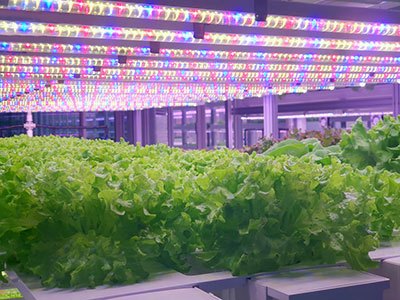
Full spectrum LED grow lights are lighting devices that emit a balanced light spectrum, designed to mimic natural sunlight. This spectrum includes all colors of light – red, blue, and green, as well as ultraviolet and infrared light. Such lights are beneficial for indoor plant growth as they cover all stages of plant growth, from germination to flowering and fruiting.
Full spectrum LED grow lights do have disadvantages. They have a high upfront cost, produce directional light, and are affected by heat, leading to aging effects and lower yields. There’s a risk of light burn and a lack of standardized specifications across manufacturers.
Using a targeted spectrum instead of a full spectrum also has advantages, but it depends on the plants’ specific needs at different growth stages. For instance, ultraviolet (UV) light enhances the flavor and aroma of certain crops (strawberries, tomatoes, blueberries), while infrared (IR) light promotes flowering and fruiting.
